 This is my fifth total solar eclipse, would you believe it?
That puts me out of the novice eclipse-viewer class.
I met a fellow who had been to twenty-four,
so I'm definitely not at the seasoned-veteran end
of the eclipse-viewer scale.
This is my fifth total solar eclipse, would you believe it?
That puts me out of the novice eclipse-viewer class.
I met a fellow who had been to twenty-four,
so I'm definitely not at the seasoned-veteran end
of the eclipse-viewer scale.
 This is my fifth total solar eclipse, would you believe it?
That puts me out of the novice eclipse-viewer class.
I met a fellow who had been to twenty-four,
so I'm definitely not at the seasoned-veteran end
of the eclipse-viewer scale.
This is my fifth total solar eclipse, would you believe it?
That puts me out of the novice eclipse-viewer class.
I met a fellow who had been to twenty-four,
so I'm definitely not at the seasoned-veteran end
of the eclipse-viewer scale.
For readers who want to skip to a specific part of it, this travelogue has the following fourteen sections.
|
|

|

|

|

|

|

|

|

|
After my previous trip with London-based Explorers I decided that I would go with them again. As they quoted me from before, "Other tour members were repeat customers of Explorers and they were not shy about telling me why. ... The big things were done right and little things were done right." Once I found out they were going to Libya, I figured I'm going to Libya.
 The
full-colour,
highly-illustrated
brochure
is titled
"Total Solar Eclipse Expedition March 2006,
Eight Night Mediterranean Cruise"
and subtitled
"Programme includes Heraklion, Benghazi, Apollonia, Cyrene,
the Sahara Desert, Tripoli, Leptis Magna, Santorini, and Athens,"
and
"Eclipse observation from south of Jalu Oasis in the Sahara Desert."
The
full-colour,
highly-illustrated
brochure
is titled
"Total Solar Eclipse Expedition March 2006,
Eight Night Mediterranean Cruise"
and subtitled
"Programme includes Heraklion, Benghazi, Apollonia, Cyrene,
the Sahara Desert, Tripoli, Leptis Magna, Santorini, and Athens,"
and
"Eclipse observation from south of Jalu Oasis in the Sahara Desert."
Explorers had trips from £995 in their literature but by the time I e-mailed them, the least expensive option available was £1295, about £150 in optional tours, and £39 for the administrative cost of getting visas into Libya. It was well worth about US $70 to have somebody else take care of all the paperwork in advance.

|
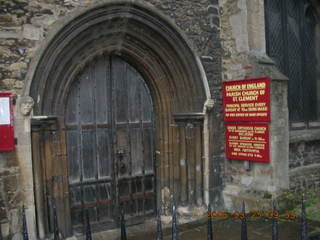
|
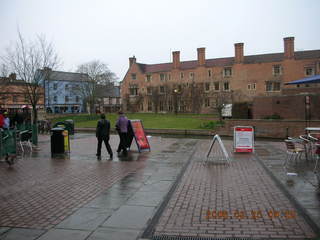
|
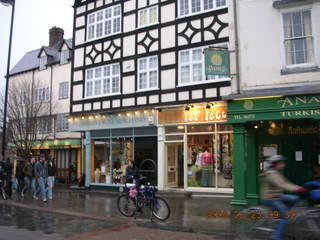
|

|
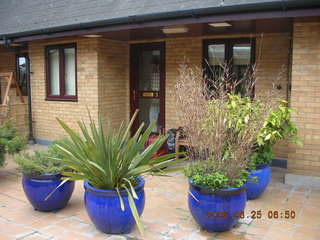
|

|
After seeing Dave Brubeck (the "Time Out" jazz fellow) the night before, I began my long airline trip on Air Canada from Phoenix to London on a good note. With eleven and a half days between leaving and returning, I decided to use SuperShuttle to get to and from Phoenix Sky Harbor Airport (PHX).
 With a three-hour connection in Calgary (YYC),
I ended up spending a few Canadian dollars
at a Tim Horton snack bar
making this a
five-currency
trip.
This was my first trip from America's southwest region
to Europe and it feels a lot longer than my earlier Europe trips
from Minnesota and the east coast.
With a three-hour connection in Calgary (YYC),
I ended up spending a few Canadian dollars
at a Tim Horton snack bar
making this a
five-currency
trip.
This was my first trip from America's southwest region
to Europe and it feels a lot longer than my earlier Europe trips
from Minnesota and the east coast.
I have a friend, Richard, from my Bell Labs days who took a teaching position at Cambridge University, the college that graduated great minds from Sir Isaac Newton to Douglas Adams. He and his new wife were happy to receive me for a few hours and I got a brief walking tour of Cambridge in the drizzle that characterizes English springtime.
 The coach (bus) trip from Cambridge to
London Gatwick Airport (LGW) was fraught with peril
as England has "British Summer Time" (BST),
which we call Daylight Savings Time (DST) in the States.
My planned travel from Cambridge to LGW was
precisely during the one-hour time change
and the coach company clearly was confused.
Not only was the connecting coach one hour late,
bad enough,
it was two hours late for some reason.
Appropriately paranoid, I left several extra hours for my trip
and arrived at Gatwick with hours to spare anyway.
The coach (bus) trip from Cambridge to
London Gatwick Airport (LGW) was fraught with peril
as England has "British Summer Time" (BST),
which we call Daylight Savings Time (DST) in the States.
My planned travel from Cambridge to LGW was
precisely during the one-hour time change
and the coach company clearly was confused.
Not only was the connecting coach one hour late,
bad enough,
it was two hours late for some reason.
Appropriately paranoid, I left several extra hours for my trip
and arrived at Gatwick with hours to spare anyway.
 In the confusion of time changes and bus schedules,
I left my spare camera battery and charger at Richard's place.
He has American-style outlets in addition to the English mains,
was nice enough to recharge my battery,
and I was dumb enough to leave it there.
Fortunately, I'm paranoid enough to bring a spare charger,
so my trip's photo opportunities weren't lost.
In the confusion of time changes and bus schedules,
I left my spare camera battery and charger at Richard's place.
He has American-style outlets in addition to the English mains,
was nice enough to recharge my battery,
and I was dumb enough to leave it there.
Fortunately, I'm paranoid enough to bring a spare charger,
so my trip's photo opportunities weren't lost.

|
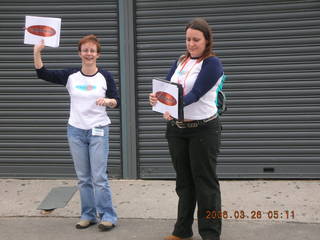
|
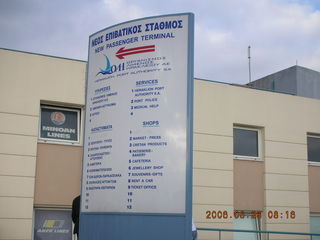
|

|

|

|
 Once I met up with the Explorers group
I had a safe-in-the-rocking-chair feeling
in spite of the long lines to board the charter flight
from LGW to Heraklion Airport (HER) in Crete.
Interestingly enough,
the only other long-line, endless-wait experience was for the
return
trip on the same charter airline, ThomsonFly,
where they clearly did not have their act together.
This is the only time I have ever been charged
for soft drinks (PepsiMax in this case)
during a flight,
although the meals were included
on the four hour flights
from England to Greece and back.
Once I met up with the Explorers group
I had a safe-in-the-rocking-chair feeling
in spite of the long lines to board the charter flight
from LGW to Heraklion Airport (HER) in Crete.
Interestingly enough,
the only other long-line, endless-wait experience was for the
return
trip on the same charter airline, ThomsonFly,
where they clearly did not have their act together.
This is the only time I have ever been charged
for soft drinks (PepsiMax in this case)
during a flight,
although the meals were included
on the four hour flights
from England to Greece and back.
When we arrived in Greece, the immigration part went very smoothly. There was a chain of people with bright "Explorers" signs to guide us to the appropriate places to enter Greece. The Greek authorities gave English passports a cursory glance and inspected the American passports closely. This may be because England is part of the European Union and we're not.

|

|

|

|

|

|

|
Knossos (Κνωσος in Greek) is a site of now-ancient ruins where kings ruled forty centuries ago, if I remember our guide. My memory might be hazy as I didn't get much sleep on the coaches the night before and not enough the two nights before. I still found time to take my own pictures of the site.
 According to myth,
King Minos defeated the Minataur
and Dædelus and Icarus began their ill-fated, human-powered flight
at this place.
According to history,
great kings ruled Crete from this place
and they built a large, living community around them
with practical living facilities and art for their minds.
According to myth,
King Minos defeated the Minataur
and Dædelus and Icarus began their ill-fated, human-powered flight
at this place.
According to history,
great kings ruled Crete from this place
and they built a large, living community around them
with practical living facilities and art for their minds.
As our guide walked us over the stones that were once floors of a great palace, we could imagine the walls and ceilings making these ruins into living spaces long ago.

|

|
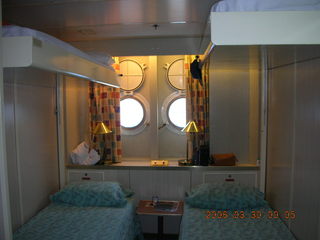
|
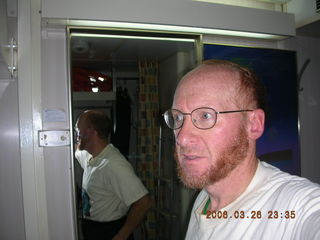
|

|

|
Our cruise ship MS Perla (Περλα in Greek) carried 770 of us eclipse weenies. In contrast, on my first eclipse trip, the Carnival ship Fascination had close to 3000 passengers, so this was a smaller boat. While they didn't have the exercise facilities I liked aboard the Fascination, seven "cardio" machines instead of jogging track and full weight room, they had the same full-service attitude in both my steward and the dining-room staff. They also had three computers with satellite Internet service, expensive for images, cheap for text e-mail like mine, and annoyingly slow in its response time.
 The Mediterranean voyage
had a short day trip to
Knossos
in Crete,
went from Heraklion, Crete, to Benghazi, Libya,
for a day and two nights,
stayed for two day trips to
Cyrene
and the
eclipse,
went from Benghazi to Tripoli
for a day and two nights,
stayed for the day trip to
Leptis Magna,
went from Tripoli to Santorini Island in Greece
for a day and two nights,
stayed for the day trip to
Santorini,
and went from there to
Athens
overnight.
The Mediterranean voyage
had a short day trip to
Knossos
in Crete,
went from Heraklion, Crete, to Benghazi, Libya,
for a day and two nights,
stayed for two day trips to
Cyrene
and the
eclipse,
went from Benghazi to Tripoli
for a day and two nights,
stayed for the day trip to
Leptis Magna,
went from Tripoli to Santorini Island in Greece
for a day and two nights,
stayed for the day trip to
Santorini,
and went from there to
Athens
overnight.
The MS Perla typically does three-day cruises of the Greek islands, so having the same passengers for eight nights was a change. The people I talked to on board seemed happy about it as most passengers spend the first two days of a cruise finding their way around the ship.
Because this was a British tour, the official currency of the ship was £ sterling rather than € euros. I got the feeling they left all the prices alone and let people pay the same number of £ pounds as would otherwise be € euros. Since £1.00 is about €1.40, that would be a nice windfall for the ship store. Then again, I'm told the store had a 30% discount to compensate for the currency difference and I happened not to see the signs.
 I had a cabin-mate named Martin whom I almost never saw.
My philosophy, to paraphrase
(or to parody) Ben Franklin, is
"Early to rise, early to bed
makes a man healthy and socially dead."
I was fast asleep when Martin came to bed
and I was up and about before he awoke in the morning.
I had a cabin-mate named Martin whom I almost never saw.
My philosophy, to paraphrase
(or to parody) Ben Franklin, is
"Early to rise, early to bed
makes a man healthy and socially dead."
I was fast asleep when Martin came to bed
and I was up and about before he awoke in the morning.
I spent a lot more time with my dinner companions Delia and George. Typically (based on my two cruise-ship experiences), cruises arrange to have the same people at the dinner tables each evening. This time we had some ad-hoc dinners, so we dined together most of the nights.

|

|

|
Talks were scheduled on our sea-voyage days and the speakers were generally excellent. John Mason's eclipse talk is a regular part of Explorers eclipse tours and he did his homework. His talk not only presented the generic stuff about solar eclipses (as I do in my discussion), but also presents the specific details of this eclipse. He predicted a dramatic corona because the sun was at near-minimum activity and a good chance of seeing the approaching umbra from the southwest and shadow bands on the sand. After the eclipse, Dr. Mason gave a "post-mortem" presentation with lots of pictures and some videos. One of the videos was good enough to see the shadow bands.
There was the usual side-topic discussion of the green flash a momentary green flicker occasionally seen at sunset over water. As we were at sea, I took several opportunities to look for it and I did not see it, although others claimed to see it almost every sunset.
 Roger O'Brien gave three historical presentations,
one on Cyrene,
one on Leptis Magna, and
a third on Santorini and Athens.
His summary was entertaining and enlightening
to give us a feel for ancient times.
Lunchtime conversation with the speaker revealed
he's an astronomer-physicist with an interest in history.
Roger O'Brien gave three historical presentations,
one on Cyrene,
one on Leptis Magna, and
a third on Santorini and Athens.
His summary was entertaining and enlightening
to give us a feel for ancient times.
Lunchtime conversation with the speaker revealed
he's an astronomer-physicist with an interest in history.
There was a general-science talk on
"The Universe in 4D,"
complete with 3D stereo red-green-anaglyph star diagrams.
The talk was a high-spirited whirlwind tour of
astronomy, cosmology, and physics.
He covered the General Theory of Relativity
and the Minkowski space-time continuum in ten minutes.
There was no real target audience for the talk
as nobody was going to learn much from the short subjects
and it wasn't satisfying to those who already understood the material.
The 3D anaglyphs did not work well
as the projection was too dim
and the point of the 3D star diagrams wasn't clear at all.
Maybe the good stuff holding the 4D talk together
wasn't visible from our 3D universe.
Being aboard the Perla in the eastern Mediterranean Sea
makes me feel like Homer's
Odysseus
in his journeys.
Like Odysseus, we had neither cable TV (just the BBC)
nor broadband Internet (just satellite)
and only the stars (and GPS) for navigation.
Galen R. Frysinger
has a nice web page of photographs
(which I found on
Google)
and I have
my own pictures.
This is an ancient site,
last inhabited as a living city 2000 year ago.
Our guides did not seem terribly organized
(or maybe I should say they were terribly organized)
and most of us wandered on our own around the site.
As we arrived at Cyrene,
some of the bus guides explained that
we had to buy permits to take pictures,
€4
for still pictures and €7 for video
while other bus guides did not.
The same thing happened three days later at
Leptis Magna.
Nobody actually checked at the site.
I suspect this is a scam to get some money from us,
but few of us are willing to argue at this point,
so we paid it.
My seat-mate for the long eclipse day was
Professor David Hughes,
astronomy professor at Sheffield,
expert on orbits of comets, fascinating company for a long day.
He gave the
talk
on comets a couple days later.
When Brian from
Explorers
drove it earlier,
the route had good roads and very little traffic,
one car per hour.
I'm guessing somebody put an X on a map for eclipse viewing
so everybody headed for the exact same place to watch,
a spot in the Sahara Desert
about 80 Km (50 miles) south of
the oasis town of Jalu.
We sure had a lot more traffic on the big day
and we were backed up terribly the last two miles.
About a mile from the porta-potties and refreshments,
with first contact twenty minutes away,
we decided to leave the bus and use the local spot
as our viewing area.
We set up our telescopes and cameras on tripods in the desert sand.
First contact is the moment when the moon's shadow
takes the first nibble from the sun's disk in the sky.
Second contact is the moment when the moon's leading edge,
as seen from earth,
reaches the far end of the sun,
the beginning of the total-eclipse phase.
Third contact is the moment when the moon's trailing edge
meets the edge of the sun,
then end of totality.
Finally, fourth contact is the moment
when the moon's trailing edge leaves the sun
and the full circle is restored.
As Dr. Mason pointed out in his talk,
this was a long eclipse, four minutes of totality.
The moon as seen from earth
was five percent larger than the sun,
large enough for it to take some time between
second and third contact.
Another factor in the eclipse duration
is the speed of the earth's rotation.
Let me explain:
the moon goes about 3550 Km/hour (2200 miles per hour)
in its orbit around the earth.
Accounting for the earth's revolution around the sun
gives a moon's-shadow speed of
about 3290 Km/hour (2000 miles per hour).
At the equator,
the earth's surface moves about half that fast in the same direction,
so a noontime eclipse lasts twice as long as a result
of the relative speed reduction.
The drawback of a large-moon eclipse
is that it's hard to see the sun's prominences (solar flares)
when the moon goes out further from the sun's surface
and there weren't likely to be many prominences
during this low-solar-activity period
in the sun's eleven-year sunspot cycle.
Second contact, totality, the Big Moment,
was coming at 13:26, just after noon.
The sun went from chipped to half, then to crescent.
The sky darkened and
the temperature drop became noticeable.
In the southwest sky there was a darker zone coming
and then light-dark shadow-band ripples started moving on the ground.
I called out "Shadow bands!"
and my eclipse neighbors later thanked me
for calling my attention to them.
The remaining narrow slit of the sun
(seen through a sun-viewing eye filter)
turned into tiny fragments of light
known as Baily's beads.
A moment later the moment came
and the corona appeared.
As the moon moved further along the sun's disk
we got another surprise,
more prominences on the other side of the sun,
glorious red points along the inner ring of the corona.
Then the third-contact side of the sun started to glow,
not the usual white precursor to the diamond ring
but a rich red "ruby broach."
As the red brightened and whitened,
I put down my binoculars and looked up one last time
to see the brilliant sun reappearing.
Others saw a double diamond ring,
the sun shining through dual lunar canyons,
two spots appearing at once.
Others also saw shadow bands again which I missed
in the celebratory atmosphere
between third and fourth contacts.
We made a ten-minute stop in Jalu
that turned into an hour and a half
and our bus driver took off without the guide.
Our bus drivers who didn't speak English
were accompanied by bi-lingual guides.
When the driver realized the guide wasn't in his seat,
he tried to ask us if the guide were somewhere else in the bus.
Then he turned back to retrieve the other member of his crew.
John Mason's eclipse post-mortem talk
scheduled for the next day was postponed two days
to give him time to put together a more-involved show
with still pictures and video.
Not only wasn't the transport any worse than Benghazi,
it was worlds better.
The buses were lined up and ready to go,
they ran smoothly on time,
and our guides were pleasant and knowledgeable.
Like Benghazi
there were the Qadhafi billboards and posters
and there were police checkpoints along the roadway.
As we arrived at Leptis Magna,
some of the bus guides explained that
we had to buy permits to take pictures,
€4
for still pictures and €7 for video
while other bus guides did not.
The same thing happened three days earlier at
Cyrene.
Nobody actually checked at the site.
I suspect this is a scam to get some money from us,
but few of us are willing to argue at this point,
so we paid it.
Our group of several hundred people had plenty of company
from other tour groups.
One large group was speaking Italian and another sounded Arabic.
When Brian from
Explorers
checked out this ancient site on his visit,
he says he was alone, the only living human being there,
his only company was the souls who lived there
nearly two thousand years ago.
 The backup science talk (in case the 4D speaker was not available)
was
Professor David Hughes
talking about unmanned missions to comets.
We got to hear the talk because the post-mortem talk
took so much preparation
that Dr. Mason's volcano talk about Santorini was canceled.
This talk was superbly accessible to a wide range of audience
from novices intrigued by actual close-up pictures of comets
to math geeks like me intrigued by the technical challenges involved.
The backup science talk (in case the 4D speaker was not available)
was
Professor David Hughes
talking about unmanned missions to comets.
We got to hear the talk because the post-mortem talk
took so much preparation
that Dr. Mason's volcano talk about Santorini was canceled.
This talk was superbly accessible to a wide range of audience
from novices intrigued by actual close-up pictures of comets
to math geeks like me intrigued by the technical challenges involved.






2006 March 28: Cyrene
 According to
Wikipedia
and
Livius,
Cyrene is an ancient Greek city
spanning five centuries from 600 BCE
near the modern city of Shahhat, Libya.
The site is about 170 hectares, 425 acres,
not quite a square mile.
According to
Wikipedia
and
Livius,
Cyrene is an ancient Greek city
spanning five centuries from 600 BCE
near the modern city of Shahhat, Libya.
The site is about 170 hectares, 425 acres,
not quite a square mile.
 The most notable aspect of the day
was the incredibly-poor coordination
of our bus transportation.
Once the Libyan authorities went through our passports,
we boarded the buses and were on our way.
The trip from Benghazi to Cyrene was just over two hours
(when Brian from
Explorers
drove it earlier)
but our convoy took almost four hours to get there
and the same to get back.
There were food-fuel stops and smoke breaks.
We were supposed to ride in a convoy with police escort,
but the bus drivers took considerable liberties and
had to be gathered by the police.
We got back to the boat several hours later than planned
and the dining room had to be flexible about
scheduled times for dinner.
The most notable aspect of the day
was the incredibly-poor coordination
of our bus transportation.
Once the Libyan authorities went through our passports,
we boarded the buses and were on our way.
The trip from Benghazi to Cyrene was just over two hours
(when Brian from
Explorers
drove it earlier)
but our convoy took almost four hours to get there
and the same to get back.
There were food-fuel stops and smoke breaks.
We were supposed to ride in a convoy with police escort,
but the bus drivers took considerable liberties and
had to be gathered by the police.
We got back to the boat several hours later than planned
and the dining room had to be flexible about
scheduled times for dinner.
 Explorers
is famous in my book for their ability
"to roll with the punches"
when things don't go as planned.
Clearly, this day's delays didn't bode wall
for the next day's eclipse trip
and I wondered just how long it was going to take
for us to hear some plan changes.
We arrived at half past seven
and by eight o'clock
we heard an announcement that the 4:30 a.m. departure
was being changed to 3:00
with breakfast at 2:00,
more flexibility from the dining staff.
Explorers
is famous in my book for their ability
"to roll with the punches"
when things don't go as planned.
Clearly, this day's delays didn't bode wall
for the next day's eclipse trip
and I wondered just how long it was going to take
for us to hear some plan changes.
We arrived at half past seven
and by eight o'clock
we heard an announcement that the 4:30 a.m. departure
was being changed to 3:00
with breakfast at 2:00,
more flexibility from the dining staff.





2006 March 29: The Eclipse
 One of my fellow travelers had an expression,
"AWA: Africa Wins Again."
She meant that no matter what you do,
no matter what extra margin you plan for,
when you're in Africa it isn't going to help.
After our 2:00 breakfast, we pulled out just after 3:00.
Ten minutes later we pulled into a petrol station
to fill up for an hour and a half.
"It takes a long time to fill up all the tanks."
Yes, it does, and that's what all night was for.
One of my fellow travelers had an expression,
"AWA: Africa Wins Again."
She meant that no matter what you do,
no matter what extra margin you plan for,
when you're in Africa it isn't going to help.
After our 2:00 breakfast, we pulled out just after 3:00.
Ten minutes later we pulled into a petrol station
to fill up for an hour and a half.
"It takes a long time to fill up all the tanks."
Yes, it does, and that's what all night was for.
 The Sahara Desert is a big and empty place,
sand as far as the eye can see.
The only carbon-based entities we saw were the rubber tires
people had abandoned on the side of the road,
tread worn smooth by the blowing winds and the sands of time.
The view is a straight line horizon
with brown sand below and blue sky above.
The Sahara Desert is a big and empty place,
sand as far as the eye can see.
The only carbon-based entities we saw were the rubber tires
people had abandoned on the side of the road,
tread worn smooth by the blowing winds and the sands of time.
The view is a straight line horizon
with brown sand below and blue sky above.
 First contact came at 12:09 as scheduled just before local noon
(11:09 local (Libyan) time,
12:09 "ship" (Greek) time,
9:09 universal time,
we stayed on ship time even when we were in Libya).
We would have liked more time to set up our equipment,
especially those with fancy stuff
and those taking time-sequence pictures of the eclipse.
My own pictures
are more modest.
First contact came at 12:09 as scheduled just before local noon
(11:09 local (Libyan) time,
12:09 "ship" (Greek) time,
9:09 universal time,
we stayed on ship time even when we were in Libya).
We would have liked more time to set up our equipment,
especially those with fancy stuff
and those taking time-sequence pictures of the eclipse.
My own pictures
are more modest.
 When the moon as seen from earth
is smaller than the sun,
the central phase is annular
(Latin for ring-shaped)
with a thin ring of red-yellow sun.
In an annular eclipse,
third contact comes before second contact.
Just before dawn of my last African eclipse day,
2001 June 21,
I was running through the maize fields
and came across a bunch of photographers
aiming their cameras east.
I said, "Waiting for third contact?"
and got some chuckles from the crowd.
When the moon as seen from earth
is smaller than the sun,
the central phase is annular
(Latin for ring-shaped)
with a thin ring of red-yellow sun.
In an annular eclipse,
third contact comes before second contact.
Just before dawn of my last African eclipse day,
2001 June 21,
I was running through the maize fields
and came across a bunch of photographers
aiming their cameras east.
I said, "Waiting for third contact?"
and got some chuckles from the crowd.
 The weather was perfect, cloudless blue sky,
light breeze, no dust storms from blowing sand.
The temperature dropped from 28°C. to 22°
(80°F. to 70°F.) as the sun shrank in the sky.
The weather was perfect, cloudless blue sky,
light breeze, no dust storms from blowing sand.
The temperature dropped from 28°C. to 22°
(80°F. to 70°F.) as the sun shrank in the sky.
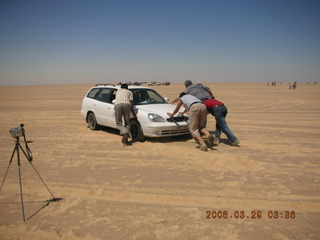 I looked up and looked at the corona
with long streamers on the sides of the sun.
Then I saw red dots on the rim of the black moon,
prominences, solar flares that we did not expect to see.
I decided I would spend thirty seconds of the four minutes
to try to take a good picture with my point-and-shoot camera
and then I gave up,
took a quick look at Venus and Mercury,
pulled out my image-stabilizing binoculars,
and enjoyed the view.
I looked up and looked at the corona
with long streamers on the sides of the sun.
Then I saw red dots on the rim of the black moon,
prominences, solar flares that we did not expect to see.
I decided I would spend thirty seconds of the four minutes
to try to take a good picture with my point-and-shoot camera
and then I gave up,
took a quick look at Venus and Mercury,
pulled out my image-stabilizing binoculars,
and enjoyed the view.
 We piled into the bus to leave and saw fourth contact
through the window of the bus.
We drove to the actual, official viewing site
where we were trying to be this morning.
The western-style porta-potties were nice
and we saw a tent city of folks who, I presume,
waited overnight at the site.
There were folks giving away some eclipse t-shirts,
a post-event general crowd scene.
We piled into the bus to leave and saw fourth contact
through the window of the bus.
We drove to the actual, official viewing site
where we were trying to be this morning.
The western-style porta-potties were nice
and we saw a tent city of folks who, I presume,
waited overnight at the site.
There were folks giving away some eclipse t-shirts,
a post-event general crowd scene.
 When we finally got back to the boat right around midnight,
the dining room crew gave us a full dinner service
compressed only by shorter intervals between courses.
Once again, they were terrific
in adapting to difficult schedule circumstances.
When we finally got back to the boat right around midnight,
the dining room crew gave us a full dinner service
compressed only by shorter intervals between courses.
Once again, they were terrific
in adapting to difficult schedule circumstances.







2006 March 31: Leptis Magna
 After the nuttiness of the bus rides in Benghazi,
and after using third-world
toilets,
some folks refused to go back into Libya in Tripoli
to see Leptis Magna.
In his talk,
Roger O'Brien described
Leptis Magna as the Roman Empire's postcard city,
built to impress visitors with its glory.
This was not a sight of a site to be missed.
I figured it wouldn't be any worse than Benghazi.
After the nuttiness of the bus rides in Benghazi,
and after using third-world
toilets,
some folks refused to go back into Libya in Tripoli
to see Leptis Magna.
In his talk,
Roger O'Brien described
Leptis Magna as the Roman Empire's postcard city,
built to impress visitors with its glory.
This was not a sight of a site to be missed.
I figured it wouldn't be any worse than Benghazi.

|
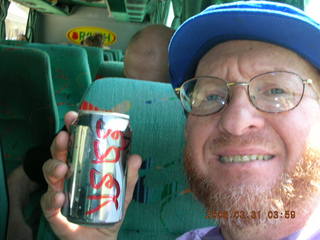
|

|

|

|

|

|

|
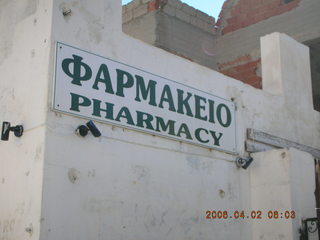
| ||

|

|

|

|
 Santorini
(Σαντορινη in Greek)
is one of the world's beautiful fantasy places.
One of my co-workers has Santorini postcard-pictures on her wall.
As I remember, the island was a large volcano known as
Thera (Θηρα in Greek)
that blew its stack sometime around 1650 BCE
as loudly as Krakatoa,
loud enough to be heard in Greece to the north
and in Crete to the south.
The remaining stunningly beautiful ring of islands is
prone to devastating earthquakes, the most recent in 1956.
Some believe Thera was the lost continent of Atlantis.
Santorini
(Σαντορινη in Greek)
is one of the world's beautiful fantasy places.
One of my co-workers has Santorini postcard-pictures on her wall.
As I remember, the island was a large volcano known as
Thera (Θηρα in Greek)
that blew its stack sometime around 1650 BCE
as loudly as Krakatoa,
loud enough to be heard in Greece to the north
and in Crete to the south.
The remaining stunningly beautiful ring of islands is
prone to devastating earthquakes, the most recent in 1956.
Some believe Thera was the lost continent of Atlantis.
I took my own pictures of this beautiful place. Our wonderful tour guide told us about the vineyards, the churches, the towns, the pumice, the desert, the tourist business, and even Santorini Airport (JTR).
 Santorini has vineyards
where they arrange the grape vines
into a basket shape to protect them against the wind.
There isn't enough of a wine business to sustain the population.
They used to make a living selling pumice from the island
but that was selling the island itself
out from under them.
Santorini has vineyards
where they arrange the grape vines
into a basket shape to protect them against the wind.
There isn't enough of a wine business to sustain the population.
They used to make a living selling pumice from the island
but that was selling the island itself
out from under them.
Now the main business of Santorini is tourism. Two of our three stops were shopping opportunities.

|

|

|

|

|

|
Our cruise ended in Athens (Αθην&alpha in Greek), the legendary cradle of democracy from ancient times and home of the Parthenon on the Acropolis. I took my own pictures of Athens. Our guide bought our tickets to the Acropolis and took us up to the top where he told us about the various temples and monuments. The admission ticket to the Acropolis is the most beautiful ticket or receipt I've seen.
 The Acropolis atop Athens is the ancient center
of defense against invaders
from the fifth century BCE.
Standing atop this ancient holy place
I found the whispers of the ancient souls
masked by the sounds of hundreds of school kids
on their spring break.
The Acropolis atop Athens is the ancient center
of defense against invaders
from the fifth century BCE.
Standing atop this ancient holy place
I found the whispers of the ancient souls
masked by the sounds of hundreds of school kids
on their spring break.
When we got to the Athens Airport (ATH) we got in line at the Thomsonfly ticket counter and waited. Then we waited and waited and waited and waited. After a few hours, some fellow came by and asked how long we were waiting. I gave the snappy answer, "What day is it?"
 It turns out that somebody put a wrong letter-digit
in the flight number stored in the computer.
As a consequence every single boarding pass
had to be filled out individually by hand.
So much for computers working they way
they were
supposed
to.
By the time I got to the agent
she was so distraught by this
that she issued tags for twelve bags of 1 Kg
rather than my one bag of 12 Kg.
It turns out that somebody put a wrong letter-digit
in the flight number stored in the computer.
As a consequence every single boarding pass
had to be filled out individually by hand.
So much for computers working they way
they were
supposed
to.
By the time I got to the agent
she was so distraught by this
that she issued tags for twelve bags of 1 Kg
rather than my one bag of 12 Kg.
I would point out that the Explorers game plan left enough extra time that all this delay still got us off the ground within ten minutes of schedule.

|

|

|

|

|
Once I got to London Gatwick Airport (LGW) I was no longer under the Explorers care umbrella. Fortunately, my hotel reservation was waiting for me at the Gatwick Moat House hotel. In spite of its English-castle sounding name, the Moat House was a very ordinary hotel. Their half-hourly airport shuttle bus is £2.50 each way.
 My LGW to PHX itinerary involved
an eight-hour flight to Philadelphia (PHL),
a friendly-but-complete going over at U.S. customs,
a three-hour wait,
and a five and a half hours to Phoenix.
When I was waiting in Philadelphia I ran into
an associate from work who had just arrived
for a meeting the next morning in Newtown Square,
just south of Philadelphia.
We were both pretty surprised to see each other.
My LGW to PHX itinerary involved
an eight-hour flight to Philadelphia (PHL),
a friendly-but-complete going over at U.S. customs,
a three-hour wait,
and a five and a half hours to Phoenix.
When I was waiting in Philadelphia I ran into
an associate from work who had just arrived
for a meeting the next morning in Newtown Square,
just south of Philadelphia.
We were both pretty surprised to see each other.
When I used to work for the airline I went to Europe for the weekend and found the seven-hour time change more fatiguing going east there than coming home west. When I went to India, a twelve-and-a-half hour change, I found myself far more fatigued coming home, maybe because it was the second night-day change, maybe because my guard was down. This ten-hour-change trip was more like India, I was fine going out and pooped coming back.
Given that I ate three full meals a day including appetizers and desserts, and given that running opportunities on the boat were limited to a treadmill, I was pleasantly surprised to find I gained no weight during my nine-day voyage.

|

|

|

|

|

|
In my last eclipse page, I had nice things to say about Explorers, their way of organizing things to run well and of adapting the plan to deal with change. Well, the Libyan organization in Benghazi was a severe test and the Explorers team of Brian, Wendy, Loretta, Dave, and Khaled rose to the challenge.
 Even before the trip began,
Explorers was on top of things.
Just as I would be about to write to ask about something,
I would get an e-mail, or a posted paper letter,
telling me what I was about to ask.
Passports and visas were all taken care of seamlessly
and all paperwork was done in advance or without long queues.
The only exception, the only queues where we had to wait,
were those for the charter flights on Thomsonfly.
Even before the trip began,
Explorers was on top of things.
Just as I would be about to write to ask about something,
I would get an e-mail, or a posted paper letter,
telling me what I was about to ask.
Passports and visas were all taken care of seamlessly
and all paperwork was done in advance or without long queues.
The only exception, the only queues where we had to wait,
were those for the charter flights on Thomsonfly.
Their challenges aren't going away, either. The next total solar eclipse on 2008 August 1 has its best viewing in the Gobi Desert in China not far from Mongolia. Of course, 2008 is an Olympic year in Beijing and Brian's Explorers crew has its work cut out for it.

|

|

|

|
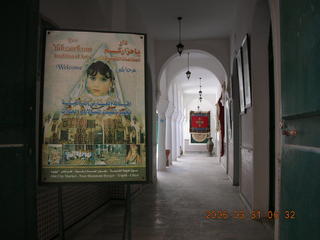
|
So what about Libya?
Benghazi left an impression of disorganization, stereotypical for Africa, also stereotypical for the middle east. The driving was crazy by American standards but I doubt an Italian would notice anything wrong. Tripoli was far better organized and the drivers were far saner.
 The other American stereotype of Libya
is about police hassles and personal risk.
There was absolutely no sense of
this kind of politics
while I was there.
The U.S. and Libyan governments
have not always been friendly
(an understatement),
but they were happy to welcome our tour,
mostly British but some Americans and Canadians.
The other American stereotype of Libya
is about police hassles and personal risk.
There was absolutely no sense of
this kind of politics
while I was there.
The U.S. and Libyan governments
have not always been friendly
(an understatement),
but they were happy to welcome our tour,
mostly British but some Americans and Canadians.
It was a bit strange for an American to pass through all the police checkpoints. The buses were waved through without a problem, but it wasn't like the United States where we can drive 3000 miles without police involvement. Also, seeing pictures of Qadhafi was a bit strange to me.

|

|

|

|

|
 Am I glad I went on this strange journey
to a new, different, and scary place?
Yes, I'm glad I went!
Am I glad I went on this strange journey
to a new, different, and scary place?
Yes, I'm glad I went!
I admit going on any kind of adventure tour with Explorers is like shooting fish in a barrel. Things may not always go right, but it takes a serious twist of fate before their customers feel the pain.
England, Greece, and Libya were fun places to visit on this trip and the eclipse was the best of the five I have seen. I hope to see my eclipse friends next time around, 2008 August 1 in the Gobi Desert in China.
What more could anyone ask?
|
2:38:23 Mountain Standard Time (MST). 3259 visits to this web page. |